The
Question
The question "which tablesaw should I buy"
or a variation thereof is one of the most frequently asked questions on woodworking
forums. When the question is so broad in scope, it is difficult to answer. Even when the
question is between types or brands, an adequate response would be quite lengthy and
dependant upon several factors.This article is an
attempt to guide the question into a more narrowly focused selection and to provide a
brief overview of the types of machines available. It is not my attempt to cover every
single brand or model of tablesaw in existence. The criteria I’ve used to select the
machines listed in the article are those generally considered by woodworking hobbyists to
be the minimum required for accurate cutting and joinery work associated with furniture
building.
Requirements
Prior to selecting any saw, there are several requirements that should be evaluated, these
alone can limit the choice of machine.
| Price$300 to $2000+ |
Generally speaking, a more expensive saw will be more
capable, powerful, safe, and accurate resulting in fewer secondary operations. That does
not mean that good work cannot be done on an inexpensive machine.
|
| Blade Tilt, Left or Right |
Many users do not have a preference while some would not
use one or the other. This is not a real issue unless the blade is set for an angle cut.
One item of note is that a left tilting arbor (or a left mounted motor) limits the choice
of a sliding table should one be desired later. Unless a sliding table is fitted, even a
right tilting saw looks like a left tilter when the right side of the rip fence is used;
most rips would be within the normal operating range of this capacity. A more in-depth
article on this feature can be found here.
|
| Voltage110v or 220v |
If you do not have 220v service or do not wish to add
it, you are limited to about a 1 1/2 or 2hp motor in the machine.
|
| Power~1hp to 5hp |
Motors above 2hp will require 220v. Of course more power
is better, a 3hp motor will perform tasks with ease that a 1.5hp motor can only accomplish
with reduced feed rates or burning or even tripping the electrical overload.
|
| Overall Size |
The contractor type saws have the largest footprint of
all the saws mentioned when compared with those of equal rip capacities. The universal
motor saws are smaller than cabinet saws and the Hybrid saws are the same size as a
cabinet saw.
|
| Local Availability |
For some, it is very important to be able to see the
machine in person before making the purchase or placing a mail order; local service also
plays a role in this.
|
| Rip Fence |
Since the rip fence plays such an important role in the
performance, accuracy, and usability equation, this feature merits almost as much
consideration as the saw itself. Personal preference plays an important role in selection
as well. The choice of OEM rip fences or whether to use an aftermarket system should be
part of the cost equation.
|
Categories
Most woodworkers agree that the tablesaw is the core power tool of the shop; if only one
piece of advise could be given on the subject, most woodworkers advise would be to
"buy the best saw you can afford". I think the cost element really is central to
the selection, if it were not, we would all have an Altendorf or Martin tablesaw in our
shop.
One very common pitfall for prospective saw buyers is
"price creep". From the bottom of the categories to the top, you can always get
a little bit better machine for about $200 more. However, before costs should enter the
equation, I think an explanation of commonly available saw types is appropriate. For
comparison purposes, I have broken them down into separate categories.
| Bench Saw These types of machines are intended for very infrequent use,
they exist only because of their very low cost and should not be considered for any sort
of woodworking involving the creation of joints. Basically they are glorified
circular saws turned upside down.
|
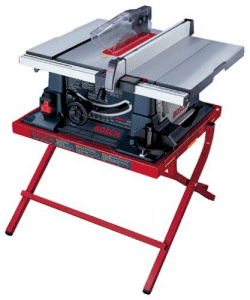 |
Job-Site Saw
This type of saw is powered by a universal motor
similar to those used in a router. These types of machines are really intended for
job-site work. They are somewhat rugged due to their intended environment, they are
portable and are able to withstand being moved about as needed.
While it is possible to do good work on these
machines they are not really intended to be the core of a woodworking shop, their cost
places them at or above the Compact Saw class. The job site saw is related to a
bench saw, they too are glorified circular saws turned upside down however they are
significantly better designed. |
- Use noisy universal motors. These motors are less
powerful than the induction motors found in larger machines.
- The table size is small, most often made of aluminum to
keep the weight down.
- Most can only rip to 24".
- Have small "trunions" and controls.
- The differences in the basic size or format of the
machine does not allow many common aftermarket accessories to be used.
- Light weight and much more portable than other saws.
- There are accessories that can increase the cutting
capacities and overall usefulness of the class but these accessories are still intended
for job-site use.
- Some machines lack a true method of setting blade angle,
they use the "yank-and-lock" method to set this critical feature.
|
| Compact Saw Like its progeny, these saws are also powered by a universal
motor similar to those used in a router. There are only four commonly available
machines in this category, the Delta (as shown), the identical looking Jet, the Ryobi
BT3100, and the Black & Decker BT2500 saw.
Compared to their job-site saw cousins these have better
and larger fence systems, better controls for raise and tilt, and larger tables. The
Delta, Jet, and B&D saws are like small versions of Hybrid saws. They have cast
iron tables and separate cranks for tilt and raise.
The Ryobi is different than these other saws in a few
ways, the main benefit the machine has to offer is its SMT (sliding miter table).
There are some additional pro / cons associated with the Ryobi, it's overall
characteristics still place it firmly in this category though. |
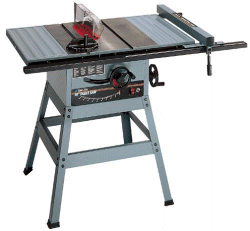 |
| The machines in this class need more
maintenance than the next step up, are not as reliable when it comes to holding settings,
and are somewhat under powered. Although these are a step in the right direction,
these machines are not truly suitable for a busy woodworking shop; that does not mean some
people do not use them this way. For occasional use in a small space these machines
may suit a users needs. The major benefit these machines have to offer is a low
price; these machines generally run between $300 and $400, the next step up is the low end
contractor saw at about $550. |
- Use noisy universal motors. These motors are less
powerful than the induction motors found in better machines.
- The table depth is about 22" compared to the more
standard 27" on the other types (the B&D is 23 1/2"). This leaves less
room on the infeed and outfeed.
- Have smaller trunions and controls (the exception is the
B&D, they are more like the Dewalt 746).
- The differences in the basic size or format of the
machine does not allow a few common aftermarket accessories used (mainly an issue with the
Ryobi).
- The best fence system on these saws is almost as good as
the lowest end fences on contractor saws.
- Far more portable than contractor saws, still not as
rugged (for throwing into the back of a truck) as a job-site saw.
- The Ryobi and B&D offer very good dust
collection.
|
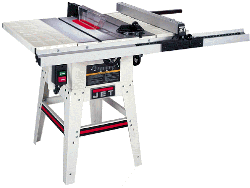 |
Contractor Saw This very popular type of saw was originally developed for the
building trades. To qualify for this designation the trunion is attached to the iron table
and the motor hangs out the back of the stand.
These machines come in two major sub-categories
within their own group. The first is a low-cost entry level machine (as shown); this
is a basic saw with no frills, these generally run about $550. The other category is
the same basic machine with an improved rip fence of increased capacity and a few other
accessories thrown in that make the machine nicer to use such as cast iron extensions
instead of stamped steel. |
The low-end machines in this class offer the
woodworker enough power, accuracy, and usability built into the tool to build furniture
without the frustration the lesser machines inject into a project; they are good values
and can be incrementally upgraded if desired.
The high-end machines have better fence systems but do not offer any other significant
accuracy or power improvements. Although they are good machines their ~$800 price is too
close to other machines to make them great values.
There are a number of improvements that can be made to the basic machine that will make it
perform better. In my view if carried to the full measure this will become a case of false
economics; no matter what is done to these machines, accessories will not turn them into a
cabinet saw. For example, it is not uncommon for contractor saw owners to eventually
spend as much on accessories and upgrades to their machines as what a cabinet saws costs
and still have an inferior (although useful) machine.
- Have trunions that attach to the iron table, this makes
it harder to align the miter gauge slots to the blade.
- Due to the way the trunion is mounted and the effect of
the cantilevered motor, some saws of this type have trouble (to varying degrees) maintaining
blade parallelism alignment with the blade tilted at an angle.
- Use direct wired switches, sometimes with removable keys
to prevent unauthorized use.
- Out of the box these machines have little or no dust
collection capability. However, a dust collection system can be made to work better
than even cabinet saws with the addition of special fittings.
- Have small (knuckle
busting) hand wheels for blade raise and tilt.
- Come in a wide variety of rip fence and extension wing
variations, this leads to a wide range of prices within the category.
- It is quite common for users to upgrade the rip fence,
pulley, belt, extension wing, and trunion alignment systems on these saws to compensate
for manufacturing design shortcuts. The cost of these upgraded components can measurably
increase the cost of the saw.
|
| Hybrid Saw These saws are a cross between a contractor and a cabinet saw but
fundamentally they are a contractor saw in a box. This class of saw used to be kind of
rare, now it appears that it is becoming quite popular with manufacturers; several new
models have been introduced lately.
What these machines really represent are the class of machine that the high-end contractor
saws aspire to be for about the same price. |
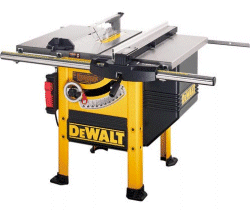 |
Examples of this class of machine are the Dewalt
746, the Jet Supersaw, the Craftsman saws, the Hitachi CF10, and saws reintroduced by Jet
and Delta formerly called "tilting arbor" (poor choice of names as all saws now
are tilting arbor types), these last being somewhat hard to find. They are differentiated
from high-end contractor saws in that they have a better trunion, better blade controls
and switch gear, dust collection, and some well designed accessories. These machines also
sell for in the range of $600 to around $900.
The main issue with the more costly machines in this class is that they come in around the
price of the low end cabinet saw which is a clearly superior machine. The Grizzly
1023s for example is close enough to the price point of these machines and potentially
offers enough improvements over them that the decision turns into whether to stay at the
Hybrid class or move into the low end of the Cabinet saw class. If one had clearly defined
requirements this decision will be a little easier. |
- Trunions attach to the iron table, this makes it harder
to align the miter gauge slots to the blade.
- The trunions for this type of saw is about the same size
of the contractor saw but designed a little differently. These saws avoid the
problem associated with contractor saws and blade parallelism errors with the blade
tilted.
- Have good or very good dust collection characteristics.
- Have better controls than contractor saws.
- Tend to have poly-vee type belts and machined pulleys
(which is good)
|
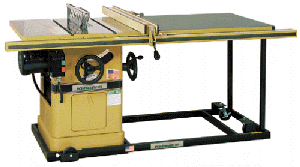 |
Cabinet Saw Cabinet saws are differentiated by an enclosed stand and a heavy trunion
that mounts to the cabinet instead of the iron table. These machines are considered by
many to be the "king" of saws. Many small cabinets shops use these machines as
the core of their work shop. |
| All the machines within this class are fundamentally
the same. There two sub-categories within the class; there are the Delta Unisaws and its
Taiwanese clones, and there are the Powermatic and General machines. The later are at the
top end of the class, they are a little bit better in overall fit and finish as well as in
trunion design. The Delta and clones represent the middle and low end of the spectrum. Generally speaking you get about what you pay for in this class. The low
end machines will require a little work to get it to be as well operating as the others
and are fitted with lower grade bearings and other items that a user will never see. As
one graduates up the cost ladder the machines become a little more refined and use better
components like bearings.
In looking at the cost difference between the low and high end of this class it may be
hard for a hobbyist to justify the added cost of the high-end machines. When in
doubt, it is always relatively safe in the middle of the pack, in this case that would be
Delta / Jet.
As to value relative to the preceding categories of machines, a
cabinet saw is a VERY good platform to base a woodworking shop on. It has all the
important accuracy features desired and they can be fitted with accessories to enhance
what ever aspects one wishes.
At the high end loaded with accessories one might be better off
stepping up a category but in the middle and low end of this class these machines are very
good values. |
- The heavy trunions attach to the cabinet instead of the
iron table, this allows the miter gauge slots to be aligned to the blade much easier.
- Motors are in the 2hp, 3hp, and 5hp range; the motors are
powerful enough to rip 2" hardwood easily.
- Have relatively poor dust collection characteristics;
they are however good at containing it within the cabinet.
- Have large easy to turn hand wheels for blade raise and
tilt.
- Have safer magnetic switch gear.
- The size and weight of the machine along with the more
massive trunion, arbor, and bearings makes them stable and accurate.
|
|
| European
SawThese
machines vary widely in form and features, this section offers only a cursory glance at
this type of saw.
Like cabinet saws these machines have an
enclosed stand however the metal is several times thicker than a cabinet saw. The
primary elements that set these machines apart from cabinet saws are:
- Designed for
sliding tables
- Better dust
collection
- Designed with
scoring blades
- Overall
increase in safety and usefulness
- Cost
|
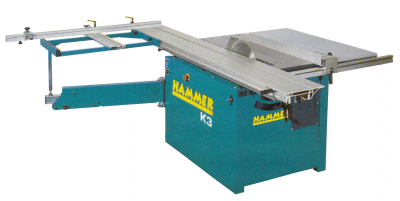 |
Depending upon the brand,
these machines can be configured with a wide array of options; this in itself can pose
problems for a potential buyer. In addition, these machine are more differentiated
than the clone-like contractor and cabinet saws. The primary elements that set these
machines apart from one another are:
- Quality
- Sliding table
mechanism
- Accessories
- Blade bore size
- Cost
|
- There is often no need to align either the blade or table
on these machines because there is no miter slot.
- Motors in the 3+hp to 5hp range in single phase, they are
also offered in 3 phase and higher horse power as well. The motors are powerful
enough to rip 2" hardwood easily.
- Have very good dust collection characteristics, not as
good as the BT3100 or DW746 but very good compared to other saws.
- Have large easy to turn hand wheels for blade raise and
tilt.
- The size and weight of the machine along with their
better overall design makes them stable and accurate.
- Are designed with scoring saw arbors, With a 10"
main blade the scoring blade can be left on the machine and raised only when needed.
On most machines, the scoring blades must be removed when a 12" or larger
main blade is used.
- Most often they do not have the capability to fit a dado
or molding head cutter to the arbor. The arbor may also be a metric bore instead of
the standard American 5/8" bore.
- Commonly offer electrical features such as soft-start and
blade braking.
- The sliding tables are much closer to the blade than is
possible on American style saws. These
sliders perform better and present a FAR better platform for jigs.
- The blade guard on the European saws are attached to a riving
knife, which raises and lowers along with the blade. The blade guard is easily removed and
re-attached.
- The sliding tables and guards make these machines quite a bit
safer to operate than American saws.
- A low end European saw is about the same price or less than a
fully equipped high-end cabinet saw with an aftermarket sliding table. Other models
can be quite a bit more expensive. There is a pretty linear relationship between
cost and quality in these machines.
- Availability: The European machines are not widely
available, if you do not live within driving distance of one of the few dealers who carry
them, the best opportunity to see one is at a woodworking show or via a visit to an owner.
For more information on sliding tables, see the Survey
of Sliding Tables article.
For a more detailed description of the differences
between these machines and a cabinet saw, see the European / Cabinet Saw Comparison
article.
|
Performance Versus
Cost
As mentioned, individual requirements and desires are important in the selection of a
machine. Tablesaws are not rocket ships and it really isn't too hard to figure out that
one category of machine is basically better than another. It is up to the buyer to
decide which machine presents the best capabilities for the cost. To that end I've
prepared the chart below to visually show the relationships between performance and cost.
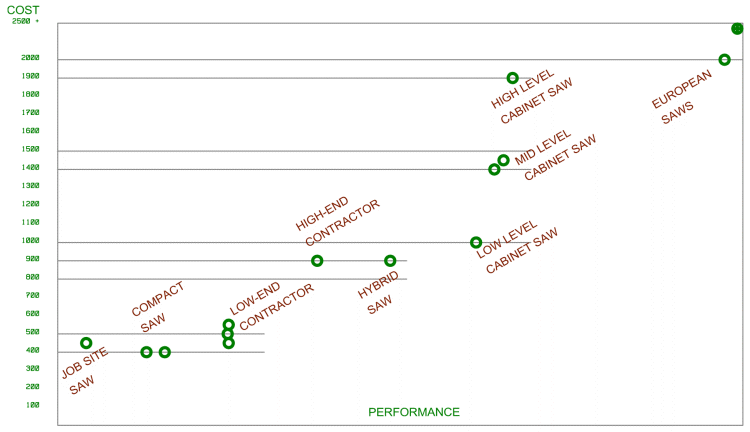
Disclaimers:
The costs given are standard costs (no sale prices etc.) including shipping but not tax.
Performance is a combined relative measure of accuracy, capacity, power, ease of use,
safety, quality......
Reviews:
As big as the Net is one would think there would be quite a bit of review information
available. Unfortunately, this does not seem to be the case. There are a few
others on the webbut they are either short "I have one and like it" types or so
obviously biased that they are not credible.
|